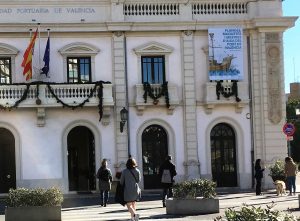
The exhibition, which is open to the public until January 14, can be visited every day of the week, including holidays, from 10 am to 2 pm.
The Clock Building will also host the traditional bells on December 31st to welcome the new year.
Valencia, December the 28th 2017. – The models and history of the port of Valencia attract the attention and curiosity of Valencian people. In just 6 days the exhibition on naval models and graphic history of the port of Valencia has captured the attention of more than 1,000 people. It is the number of visitors who until 12 noon today have been interested in the Plànols, Maquetes i Mestres d’Aixa of the Port de Valencia. The exhibition, which will be open to the public until January 14, is free and can be visited every day of the week, including holidays, from 10 am to 2 pm.
With this exhibition, the Port Authority of Valencia takes up the organization of cultural activities open to the public in the Clock Building, a reference point for the entire Valencian port community and the relationship between the port and the city of Valencia. The PAV also plans to welcome the next year 2018 with the traditional chimes in the same Clock Building.
The exhibition gathers the graphic history of the evolution of the Port of Valencia through 10 images and 15 boats models made by ribera carpenters, known in Valencian lands as “Mestres d’Aixa i Calafats”. The 15 models that are shown in the exhibition are the result of decades of work by Joaquín López Martínez, one of the last “Mestres d’Aixa” and José Carrión Vicente, recognized masters of naval models that give these works the rigor of execution, based on historical research and deep knowledge of an ancient trade.
The exhibition also shows, through images and blueprints, the creation, evolution and transformation of the port of Valencia throughout history. In this way, it collects the changing uses that the coastal facade of Valencia has experienced from the schematic drawing of the Vilanova del Grau drawn up in 1563 by Antoni Van Den Wijngaerde for Felipe II, through the works of the port that were made on the beach of Valencia in 1800 or those of widening and improvement of 1894. The last aerial image is taken in October of 2017; a blunt zenith photograph that contrasts with what was the coastline of Roman Valencia.

